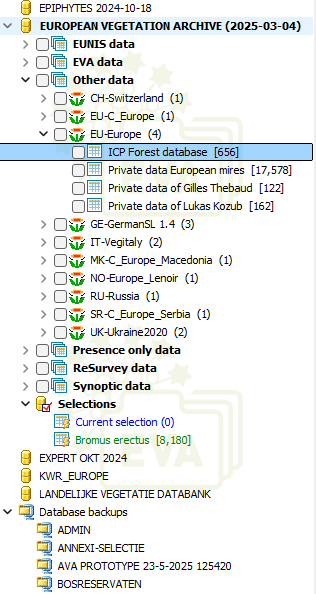The organisation of data in Turboveg3 is very different from that in Turboveg2. In Turboveg2 a data repository (e.g. the Dutch National vegetation database) consists of many different databases, where each database is built up by a set of dBaseIII+ files and its corresponding index files. A repository may therefore comprise hundreds of files, making the entire system sensitive to data corruption, especially when running Turboveg2 in a local network.
In Turboveg3 all data is organised in a single SQLite database file.SQLite databases have been proven to be very stable and are in general very fast in querying for data, also in a multi user environment.
Multiple Turboveg2 databases can easily be imported in a Turboveg3 database and are presented as datasets.The database structure and dictionary of each Turboveg2 database are preserved in the Turboveg3 database.
In Turboveg3 datasets are organised according to taxonomy, and taxonomies into dataset groups. By default all datasets are assigned to a single dataset group ('Core'), but this can easily be changed. Datasets can easily be merged, split, assigned to other or new dataset groups under the condition that they are connected to the same taxonomy. Names at any level can easily be changed via the MANAGE menu, except for the name of the database. Names of datasets and stored selections can also be changed directly in the organisation tree of a database. To edit a selected name press F2 or click the name and hold the mouse still for at least one second.
Turboveg3 can deal with multiple databases, although each database is an independent entity. In the screenshot below multiple databases are listed in the index. One of the databases, an instance of the European Vegetation Archive, is active and showing all levels of organisation, with for example 'Other data' as dataset group, EU-Europe as taxonomy, and 'ICP Forest database' as selected dataset.
The last items in the list concern backups of the databases. By double clicking on one of the backup names the restore process of the included database will be started automatically.
